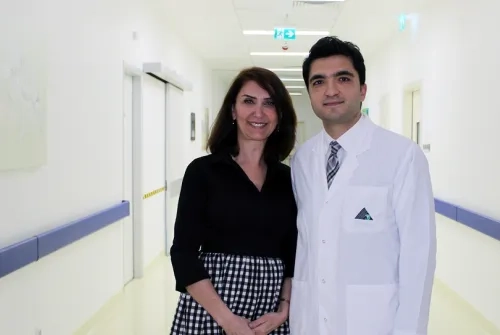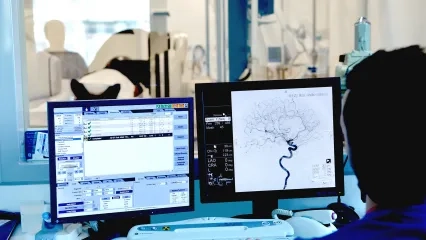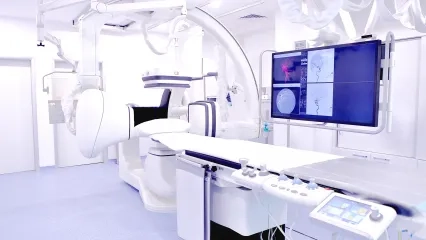Alo Yeditepe
Alo Yeditepe
The Cause of Abdominal Pain Has Not Been Found for Years... Varicose Veins Appeared in Her Ovary
Funda Sahillioğlu, 48, living in Istanbul, has suffered severe abdominal pain and distention for seven years. The actual disease of Sahillioğlu, who had been treated for years on the grounds of ovarian cyst, was revealed three months ago. It was determined that Sahillioğlu, the mother of 2 children, had varicose veins in her ovaries but had not been noticed for a long time and she has regained her health with a one-day long operation. The disease, seen in women between the ages of 20-50, is defined as “hidden disease” by experts.
Funda Sahillioğlu, Personal Development Specialist, living in Istanbul, consulted gynaecologist seven years ago due to severe pain in her lower abdomen. The doctor administered the treatment, saying it could be an ovarian cyst. The pain of the young woman, the mother of 2 children, did not respond to the treatment. Sahillioğlu, who had been experiencing abdominal pain and distention for years, was diagnosed with uterine and ovarian varicose veins (pelvic venous congestion syndrome) in ultrasound and medicated computed tomography performed three months ago at Yeditepe University Koşuyolu Hospital.
Treated With The Process of “Enlarged Veins Embolization”
Under the supervision of Assoc. Prof. Dr Melih Topcuoğlu, Interventional Radiology Specialist, Sahillioğlu, who had suffered for years from the disease caused by the enlargement of the veins in her lower abdomen and groin, was treated with an endovascular embolization process by entering through a pinhole opening in veins in the neck and accessing the ovarian and uterine veins that have become varicose veins. Sahillioğlu, who regained his health with embolization of enlarged veins that caused pain, said that she felt as if she was reborn.
Known As The Hidden Disease Of Women
Pelvic venous congestion syndrome is generally seen in women between the ages of 20-50. The disease, which progresses with the enlargement of the veins in the lower part of the abdomen, around the ovaries and uterus and in the groin, is defined as the hidden disease of women.
“The Distention Went Away Only When I Lay Down”
Sahillioğlu, stating that the abdominal area swells more than it does when standing, expressed that she heard about the disease of the uterus and ovarian varicose veins for the first time. Sahillioğlu, stating that she was experiencing restlessness due to pains, said, “It was putting pressure on my groin, and there was the pain. This was creating unrest in me. I was having these problems if I stood for 10 minutes even while washing dishes and cooking. The distention went away when I lay down.”
“I am not getting tired, and I have no pain."
Sahillioğlu, expressing the difficulties in her life, stated that “I was making a joke of “I gain a dress size” to my friends. Nobody would believe me. There was such a distention that it affected my waist. I was having a nervous breakdown. It was more swollen, especially in the summer. The pain was incredibly affecting my daily comfort. I wanted to finish my work as soon as possible and lie down. I was suffering pain while doing sports and walking. I was just feeling well when I was lying down. Now I am not tired, and I have no pain. It's so comforting to have no pain. I feel so good. I have never heard of a disease called ovarian and uterine varicose veins before.”
“No Response To The Treatment Since The Correct Diagnosis Has Not Been Made”
Yeditepe University Koşuyolu Hospital Interventional Radiology Specialist Assoc. Prof. Dr Melih Topcuoğlu, giving information Information about the treatment, said, "The patient came to us with the complaint of distention and groin pain. The treatments she had previously received haven't eliminated her ailment. The uterus and ovarian varicose veins are not considered because they are rarely seen, and since the diagnosis was not made correctly, there was no response to treatment. If the pelvic venous congestion syndrome is not treated, the life quality and comfort of the people is seriously impaired. Common pains occur during the day, and these pains can wake the patient from sleep at night. The important thing here is to bring to mind the disease and make the right diagnosis.”
Gynaecologists Should Bring To Mind This Ailment
Asst. Prof. Dr Topcuoğlu, stating that together with the prominent enlargement of the veins, the blood accumulating there causes pain, restlessness and distention, spoke to “because like all the veins in the body, the vein in the uterus and ovaries also carry blood towards the heart. When it can't carry, the blood begins to pond below. Ponding causes pain, as in our patient. If this disease does not come to the mind of gynaecologists, many patients lose the chance to be treated.”
“We Performed Embolization of Enlarged Veins”
Assoc. Prof. Dr Topcuoğlu, explaining that they performed embolization of enlarged parts by entering into the enlarged veins, used following expressions “We use vena cava in the right groin or neck to reach the uterus and ovarian veins. We proceed through the vein by seeing under the guidance of ultrasound and fluoroscopy (x-ray). After entering the vein that we want to make embolization, we continuously make embolization of the entire vein, starting from the very beginning. We use coils or liquid embolic agents. After placing them in the vein, the blood clots. As soon as we make embolization of the veins, the patient sees the effect of the treatment on the table and the pains disappear. The patient is discharged during the day and goes home.”
The Cause of 5 Percent of Lower Abdominal Pain Complaints in Women
Assoc. Prof. Dr Topcuoğlu, giving clues on the disease, said, "The operation lasted 4 hours as the patient's veins enlarged at an advanced level than normal. But if the disease is not progressed much, the procedure ends in 1-1.5 hours. In 5 per cent of women who report severe lower abdominal pain to gynaecologists, the uterus and ovarian varicose veins are seen. Long-standing lower abdominal and groin pain or pain after sexual intercourse is the clue for this disease.”
It Is Seen In Women Who Give Birth At Frequent Intervals
Yeditepe University Hospital Interventional Radiology Specialist Assoc. Prof. Dr Melih Topcuoğlu, saying that this disease is usually seen in women who give birth a lot, said, “But it can also be seen structurally in women who have never given birth. It is a case related to the patient's blood flow. Women suffering from severe menstrual pain should also consult a doctor if the pain does not go away despite the necessary gynaecological treatments. We expect the pain that occurs during the menstrual period to be regressed in patients with this treatment.”
Varicocele in Men
Assoc. Prof. Dr Member Topcuoğlu, stating that the ovarian and uterine varicose veins are seen in men is called varicocele, said, “In other words, we call it varicocele, because the veins that drain the testicles are not able to carry the blood to the heart and become insufficient, causing the blood to be ponded in the vein of the testicle and enlarged. Veins that cause varicocele can be embolized through intravenous treatment methods, except for the ligation method done by urologists. ”
About
Faculty and Year of Graduation:
Marmara University Faculty of Medicine (English), 2009
Alo Yeditepe





